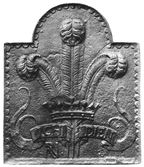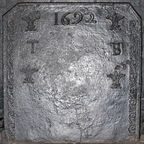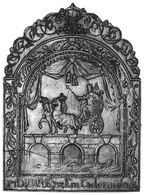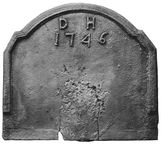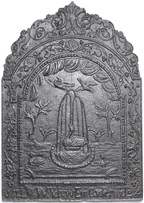-
229
Description: Rectangular with superimposed arch; embattled, cavetto moulded edging, with the top edge of the rectangle interrupted; shield, garter, crown, supporters and motto of the English Royal house of Stuart; rose and thistle plants above lion and unicorn supporters respectively; initials split by crown; date below garter.
Notes: An example in the Musée d'Agen in France is illustrated by Carpentier (1912, p.419). A different version is at Newick Park, Sussex (no. 502).
Copies of this fireback are known.
Inscription: I R / HONI S OIT QVI MAL Y ..ENSE / 16 19
Arms: English Stuart royal
- Decoration tags:
- rectangular with round arch (shape)
- embattled cavetto (edging)
- whole carved pattern
- armorial
- royal
- text
Manufactured: in 1619 in England.
Current location: National History Museum, St Fagans, Glamorgan, Wales.
Museum number: 48.354/85 (part of the Welsh National History Museum museum group)
Citation: Carpentier, H., 1912, Plaques de Cheminées (Paris, published by the author).
-
232
Description: Rectangular shape with bottom corners missing; no edging; central shield, helm, crest and mantling of the Lewis family: quarterly 1st, sable a lion rampant argent (Lewis of Y Fan), 2nd, sable a chevron between three fleurs de lys or (Einon ap Collwyn), 3rd gules three chevronels argent(Iestyn ap Gwrgan), 4th, sable a chevron between three spear heads argent embrued gules (Bleddyn ap Maenyrch); initials split by armorial stamp (’E’ over-stamped); date, formed from single numerals, below arms.
Notes: The arms are those of Sir Edward Lewis, of Van, who purchased St Fagans Castle in 1616. The same armorial stamp was used to model the arms on a lead cistern outside the front door of the castle. It is possible that this fireback was cut down from a larger fireback.
Inscription: E L 1620
Arms: Sir Edward Lewis of Van
- Decoration tags:
- rectangular (shape)
- none (edging)
- carved stamps
- individual letters
- individual numbers
- armorial
- text
Manufactured: in 1620 in the South Wales area of Wales.
Current location: National History Museum, St Fagans, Glamorgan, Wales.
Museum number: 48.354/84 (part of the Welsh National History Museum museum group)
- Attached to series:
- Personal armorial firebacks
- Welsh armorial firebacks
- Bristol armorial group
-
233
Description: Arched rectangular central panel, bead edging, a stork, to the left, its beak in the top of a tall vase, a fox seated to the right, a tree behind; arched rectangular border, fillet edging, swags of fruit bunches (missing at the sides) suspended from ribbon, inscription below central panel; on top, symmetrical floral swirls and flowers.
Notes: The scene is drawn from 'The Fox and the Stork', one of Aesop's fables. A recasting. Formerly at Ffynnon Deilo, Pendoylan, Glamorgan.
Copies of this fireback are known.
Inscription: 16 NDW 97
- Decoration tags:
- 'Dutch' (shape)
- fillet (edging)
- whole carved pattern
- pictorial
- mythological
- text
- animals
- objects
Manufactured: in 1697 in the Siegerland area of Germany.
Current location: National History Museum, St Fagans, Glamorgan, Wales.
Museum number: 59.461 (part of the Welsh National History Museum museum group)
- Attached to series:
- 'Dutch' NDW series
-
234
Description: Arched rectangular shaped; cavetto moulded edging, scalloped top and sides; Prince of Wales’ badge of three ostrich feathers emerging through a coronet; symmetrical scroll with elaborate swirls, bearing motto; monogrammed initials at bottom, left of centre.
Notes: The scalloped edging and RN monogram have been noted on other firebacks, suggesting a common pattern maker. Formerly from Burwash, Sussex.
Copies of this fireback are known.
Inscription: ICH DIEN / RN
- Decoration tags:
- rectangular with round arch (shape)
- scalloped cavetto (edging)
- whole carved pattern
- heraldic
- monogram
- royal
- text
Manufactured: in the early- to mid-17th century in England.
Current location: National History Museum, St Fagans, Glamorgan, Wales.
Museum number: 20.177/1 (part of the Welsh National History Museum museum group)
- Attached to series:
- RN series
- Prince of Wales firebacks
-
235
Description: Fragment; canted rectangle; twisted rope edging (top and sides); repeated scroll strip stamp along each side; date, top centre; a fleur-de-lys stamp repeated three times vertically down left side, probably mirrored on right side (top fleur visible).
Notes: Use of the same stamps indicates a common source with a variant dated 1692 (see Fireback no. 237).
Inscription: 1694
- Decoration tags:
- rectangular with canted top corners (shape)
- rope (edging)
- simple stamps
- carved stamps
- individual numbers
- heraldic
- text
- objects
Manufactured: in 1694 possibly in the South Wales area of Wales.
Current location: National History Museum, St Fagans, Glamorgan, Wales.
Museum number: 61.49/3 (part of the Welsh National History Museum museum group)
- Attached to series:
- St Fagans series
-
237
Description: Canted rectangle; twisted rope edging (top and sides); repeated scroll strip stamp along each side; date, top centre, between two fleurs de lys; initial below each fleur, with a fleur below each initial.
Notes: A damaged variant (see Fireback no. 235), probably with six fleurs, no initials, dated 1694, is also known. Formerly at Great House, Llanllowell, Monmouthshire.
Inscription: 1692 / T B
- Decoration tags:
- rectangular with canted top corners (shape)
- rope (edging)
- simple stamps
- carved stamps
- individual letters
- individual numbers
- text
Manufactured: in 1692 possibly in the South Wales area of Wales.
Current location: St Fagans Castle, St Fagans, Glamorgan, Wales.
Museum number: 42.82 (part of the Welsh National History Museum museum group)
- Attached to series:
- St Fagans series
- Date & initials firebacks
-
238
Description: Arched rectangular shaped central panel with bead-and-pellet edging on a wide fillet; crowned figure, holding a sceptre in his right hand, sitting in a chariot drawn to the left by two, caparisoned horses with ostrich feather head-dresses; the whole upon a three-arched bridge with keystones and a string course, waves beneath; above, swagged drapery with two tassels hanging from the centre; arched rectangular shaped border with fillet edging, symmetrical, descending oak leaf and acorn branches, with a looped 'W' in each shoulder; inscription at base; on top, symmetrical scrolled plant tendrils and berries. A single central vertical plankline.
Notes: One of a series produced in the same year. All incorporate the looped 'W' motif which may be intended to identify the pattern maker. The design is derived from a personification of Europe, one of a set of playing cards entitled Jeu de la Géographie, designed by Stefano della Bella for Louis XIV. The inscription translates as 'God is our strength'.
Copies of this fireback are known.
Inscription: 17 DVW Ydyw Ein Cadernid 24
- Decoration tags:
- 'Dutch' (shape)
- fillet (edging)
- whole carved pattern
- planklines
- pictorial
- allegorical
- text
- animals
- humans
- objects
Manufactured: in 1724 in England.
Current location: Tredegar House, Pencarn Way, Duffryn, Newport, Gwent, Wales.
Museum number: F81.233 (part of the Welsh National History Museum museum group)
- Attached to series:
- 1724 series
- Welsh inscription series
- British 'Dutch' style firebacks
-
239
Description: Arched rectangle with stepped, canted shoulders; fillet and astragal edging (top and sides only); initials above date at top of plate.
Notes: The shape and edging are uncommon. Formerly from Caerphilly, Glamorgan.
Inscription: D H / 1746
- Decoration tags:
- rectangular with canted top corners and round arch (shape)
- fillet (edging)
- individual letters
- individual numbers
- text
Manufactured: in 1746 in Wales.
Current location: National History Museum, St Fagans, Glamorgan, Wales.
Museum number: 44.303/1 (part of the Welsh National History Museum museum group)
- Attached to series:
- Date & initials firebacks
-
1070
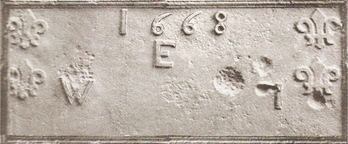 ? x ? mm
? x ? mmDescription: Rectangular; ovolo-moulded edging; two fleurs-de-lys arranged vertically top left and top right; top centre, date; below date, initials WEI in triad.
Notes: Said to have been made by George White, iron founder, of Monmouth. Formerly from Newport, Monmouthshire.
Inscription: 1668 / W E I [triad]
- Decoration tags:
- rectangular (shape)
- ovolo (edging)
- carved stamps
- individual letters
- individual numbers
- heraldic
- text
Manufactured: in 1668 possibly at Tintern Furnace in the Forest of Dean area of Wales.
Current location: National History Museum, St Fagans, Glamorgan, Wales.
Museum number: 25.21 (part of the Welsh National History Museum museum group)
Citation: Kissack, K., 2003, Monmouth and its Buildings (Almeley, Logaston Press).
- Attached to series:
- Date & initials firebacks
-
240
Description: Arched rectangular shaped central panel with bead-and-pellet edging on a wide fillet; ground with birds, and trees behind; in the centre a circular fountain rim with a swan on a plinth surrounded by water, with jets of water rising from the swan’s mouth and descending on either side; above, a heron and a goose fly to the left; under the arch, swags of drapery; arched rectangular shaped border with fillet edging, symmetrical floral fronds descending from a scallop shell, top centre, with a looed 'W' in each shoulder; inscription at base between date; on top, symmetrical scrolled plant tendrils. A single central vertical plankline.
Notes: One of a group of firebacks, all of the same date, some of which have the same Welsh inscription which translates as 'God is our strength'. All incorporate the looped 'W' motif which may be intended to identify the pattern maker. The design is adapted from an illustration of fountain no. XXXIX, 'Les Cannes et le Petit Barbet' in Labyrinthe de Versailles by Sébastien le Clerc (1677); the flying heron and duck are copied from illustrations by Francis Barlow (c1626-1704) or from engravings of his work by Wenceslaus Hollar (1607-77).
Copies of this fireback are known.
Inscription: 17 DVW Ydyw Ein Cadernid 24
- Decoration tags:
- 'Dutch' (shape)
- fillet (edging)
- whole carved pattern
- planklines
- pictorial
- architectural
- text
- animals
- objects
Manufactured: in 1724 in England.
Current location: Newton House, Dinefwr, Llandeilo, Carmarthenshire, Wales.
Museum number: F83.116 (part of the Welsh National History Museum museum group)
Citation: Lloyd, N., 1925, 'Domestic Ironwork I', Architectural Review, 58, pp. 58-67.
- Attached to series:
- 1724 series
- Welsh inscription series
- British 'Dutch' style firebacks



